Vol 5 No. 27 TROPIC LIGHTNING NEWS July 6, 1970
Index
Last Unit Returns
25th Back in Vietnam
CU CHI - After almost eight weeks of routing through hoarded enemy supplies,
the 25th Division is back from Cambodia.
The last unit to return was the 3rd Squadron, 4th Cavalry, which had been
under the operational control of the 1st ARVN Airborne Division. All other
units had returned in mid June.
Cambodian operations began for the 25th Division with Operation Bold Lancer
when the 1st Brigade slashed into Communist sanctuaries with air assaults and
fast-moving mechanized units.
The surprised enemy fled. He offered almost no resistance, fighting only
when he couldn't avoid the US troops sweeping through areas formerly safe for
the NVA.
On May 10, the 2nd Brigade stabbed into Cambodia with Operation Toan Thang 43
north of the Dog's Face cutting off enemy escape routes from the Fish Hook
region and ripping into enemy training and resupply areas.
The next day, four battalions surrounded what was believed to be part of the
Central Office for South Vietnam (COSVN) headquarters. As the US units
tightened their grip on the area, they squeezed out the largest numbers of
caches during the operation to that point.
The 1st Brigade withdrew from the area below the Dog's Face and units were
rotated in the more productive area to the north. For weeks the laborious
search went on as US forces conducted a grid square by grid square search of the
plentiful cache sites.
As the operation drew to a close, the enemy became active, but, as one
commander pointed out, it was a little late. So much materiel had been captured
that the figures had become almost meaningless.
Shortly before the 3/4 Cav came back, the list ran something like this: more
than 700 small arms captured, 130 crew served weapons, 45 tons of ammunition,
1,700 tons of rice, 58 vehicles, 5,760 pounds of communications equipment,
13,900 pounds of medical supplies and 1,500 pounds of documents.
|
Photos on pages 3,4,5 and 7 |
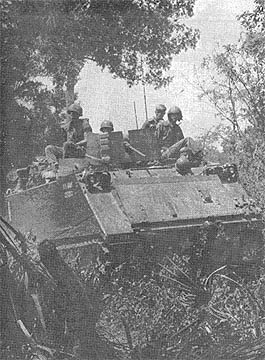 |
MISSION ALMOST DONE -- Shortly before coming back to Vietnam, an Armored personnel carrier of the 2nd Battalion (Mech) 22nd Infantry, searched for enemy arms and supplies near Krek. |
Manchus Upset Staging System
By SGT WILLIAM E. ZARRETT
THIEN NGON - A recent search by a 25th Division Infantry company northwest of
the Dog's Face in Cambodia led to the discovery and destruction of a vital enemy
staging area.
While on a routine search and destroy operation, the 2nd Platoon of Charlie
Company, 4th Battalion, 9th Infantry, moved into and secured an area three
hundred meters square, allowing a detailed search of the more than sixty bunkers
and buildings the men had found there. Among the buildings were a shrine, a
mess hall with six earthen stoves and a separate area for dish washing, two
grain huts - one for grinding and one for storage -and one classroom.
Numerous wooden training aids found in the classroom gave the soldiers a
better idea of enemy instruction. The models included mock-ups of most of the
enemy's weapons, plus carvings of American aircraft and straw versions of allied
tanks.
Taking more than two days to destroy the entire training complex, "Manchus"
upset what is thought by the American Command to have been one of the major
staging areas for enemy actions in Vietnam's Tay Ninh Province.
"The way the whole place was built and camouflaged, they (the enemy) must
have been there for quite some time, and must have been planning to stay," said
Private First Class Johnny Williams, of Youngstown, Ohio.
Engineers Build Civilian Bridge
MEMOT, Cambodia - One of the first casualties of operations in Cambodia was a
light, French-built bridge over a stream that bisects this prosperous city.
But when U.S. troops withdrew, they left the business community a new bridge
built especially for commercial use.
After the first bridge was destroyed, Alfa Company of the 65th Engineer
Battalion quickly replaced the span with a tactical bridge to permit military
traffic to pass.
Later, as the deadline for American troop withdrawal drew near, it became
apparent that the tactical bridge would have to be removed for future use. An
order quickly went out stating that some provision would have to be made to
bridge the stream so that normal civilian commerce could continue.
The Engineers' answer was to replace the tactical span with a Bailey Bridge.
Alfa Company removed the old span while Bravo Company constructed the new.
The villagers took in the event with all the excitement of a national
holiday. The bridge site was constantly surrounded with hundreds of onlookers,
while other villagers prepared native dishes and peddled their wares as if the Engineers' presence was cause for a
village-wide celebration.
Bravo Company, under the leadership of Captain Lawrence Oliver, and
well-organized from previous experiences, completed its mission in less than six
hours.
When asked their reaction to the bridge building by the engineers, a group of
elders bowed vigorously and repeated, "Thank you, Thank you."
Dragons Move into Enemy's Home
By SP4 RICH ERICKSON
TASUOS, Cambodia -Airlifting Delta Company, 2nd Battalion, 14th Infantry
"Golden Dragons" south of the Dog's Face area of Cambodia recently proved to be
a profitable operation.
Drawing no resistance, the Dragons quickly located three hootches containing
North Vietnamese military uniforms, a small machine shop, two tons of rice,
numerous medical supplies and four motor launches.
The company then moved north through 200 yards of dense jungle and found
themselves in the midst of a 30 hootch complex. A systematic search of the
numerous bunkers and hootches uncovered another two tons of rice, medical
supplies, an SKS rifle and six RPG rounds.
Over the company radio a platoon leader exclaimed, "Hey, we found the motor
pool." The NVA motor pool consisted of a hootch containing four motorcycles and
parts for about 50 bicycles.
As the company moved out of the area one man remarked, "It looks like we put
a sizable dent in Charlie's travel accommodations."
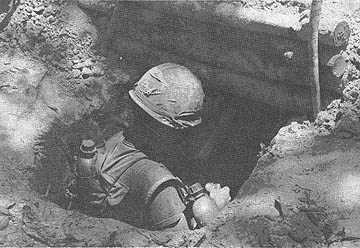 |
SETTING UP C-4 -- Captain Bennet S. Jones of Delta Company, 2nd Battalion, 14th Infantry, readies C-4 to be used to destroy an enemy bunker in Cambodia. The bunker was found in a 30-hootch complex south of the Dog's Face. (Photo by SP4 Rich Erickson) |
Page 2 TROPIC LIGHTNING NEWS July 6, 1970
Decorated
| BRONZE STAR (VALOR) | |
| CPT CarrolI J. Alvarez, Co C, 4th Bn, 9th Inf CPT Charles E. Criswell, Co B, 2d Bn 27th Inf CPT Gary A. Franklin, Co A, 2 d Bn, 12th Inf CPT Melvin A. Greenroad, HHC, 2d Bn, 34th Armor CPT Oleh B. Koropey, B Trp, 3d Sqdn, 4th Cav CPT Thomas H. Pardue, Co B, 4th Bn, 9th Inf CPT Lynn Tew, HHSB, 7th Bn, 11 th Fld Arty 1 LT Bruce S. Brooks, Co A, 4th Bn, 9th Inf 1 LT Thomas L. Bush, HHSB, 1st Bn, 8th Fld Arty 1 LT Lawrence P. Forster, Co A, 2 d Bn, 34th Armor 1 LT Albert C. Flagg Jr, Co B, 1st Bn, 5th Inf 1 LT Thomas G. Harris, Co D, 3d Bn, 22d Inf 1 LT Richard T. Hirsch, Co A, 4th Bn 9th Inf 1 LT John T. Ligon C Btry, 1st Bn, 8th Fld Arty 1 LT Harold R. McCoy, Co B, 1st Bn, 5th Inf 1 LT Gary G. Meyer, Co C, 4th Bn, 9th Inf 1 LT Melvin A. Miller, Co E 2d Bn., 12th Inf 1 LT Ben Litz Read, Co A, 3d Bn, 22d Inf 1 LT Juan Rivera, Co A, 4th Bn, 9th Inf 1 LT Hector Saenz, Co B, 1st Bn, 5th Inf 1 LT William B. Speer, Co E, 2d Bn, 14th Inf 1 LT Less P. Wright, Co D, 3d Bn, 22d Inf 2 LT Dick F. Dent, Co D, 3d Bn,22d Inf 2 LT Theodore P. Pytash, Co A, 4th Bn, 9th Inf 2 LT James A. Smith, Co C, 4th Bn, 9th Inf 2 LT Charles A. Thomas, Co A, 4th Bn, 9th Inf CSM August Myszka, HHSB, 1st Bn, 8th Fld Arty 1 SG Rudolph V. Chandler, B Trp, 3 d Sqdn, 4th Cav SFC Alex Blackburn, Co C, 2d Bn, 27th Inf SFC Joseph L. Cameron, Co B, 2 d Bn, 34th Armor SFC Harry C. Coons, Co D, 3d Bn, 22d Inf SFC Bernard J. Lloyd, Co A, 4th Bn, 9th Inf SFC Marion D. Masterson Co E, 2d Bn, 14th Inf SFC Floyd Shick, B Trp, Jd Sgdn, 4th Cav SSG John C. Binger, C Btry, 1st Bn, 8th Fld Arty SSG Charles L. Coffman, HHSB, 1st Bn, 8th Fld Arty SSG Lowell H. Coomes, C Btry, 1st Bn, 8th Fld Arty SSG Seba E. Gaston, F Co, 75th Inf SSG Charles R. Power, Co A, 4th Bn, 9th Inf SSG Joseph J. Turner, D Trp, 3d Sqdn, 4th Cav SSG Jack A. Weiss, Co A, 4th Bn, 9th inf SGT Michael D. Andrianse, B Trp, 3d Sqdn, 4th Cav SGT Dennis Avery, Co B, 1st Bn, 5th t of SGT Robert W. Bodley, HHSB, 1st Bn, 8th Fld Arty SGT Charles Bryson, Co B, 1st Bn, 5th Inf SGT Joseph P. Cairo, Co A 4th Bn, 9th Inf SGT William S. Chriswell, tz Co, 75th Inf SGT Kerry W. Dickson, Co D, 3d Bn, 22d Inf SGT Carl R. George, Co E, 3d Bn, 22d Inf SGT Edgar L. Hannah, C Btry, 1st Bn, 8th Fld Arty SGT Lewis Hyde, Co B, 1st Bn, 5th Inf SGT R. W. Lowe, Co D, 2 d Bn, 12th Inf SGT Lacy McCarty Jr, C Btry, 1st Bn, 8th Fld Arty SGT Larry D. Melton, C Btry, 1st Bn, 8th Fld Arty SGT William R. Morres, B Trp, 3d Sqdn, 4th Cav SGT Rudy S. Nieto, Co B, 1st Bn, 6th Inf SGT Anthony Piggott, Co A, 4th Bn, 9th Inf SGT Carey J. Pratt, Co D, 2 d Bn, 14th Inf SGT Cleman Quade, HHC, 4th Bn, 23d Inf SGT FarrelI D. Sanders, Co B, 1st Bn 5th Inf SGT John L. Schafer, Co C, 3d Bn, 22d Inf SGT John W. Stubbs, Co E, 2d Bn, 1ith Inf SGT John E. Sumpter, Co D, 3d Bn, 22d Inf SGT Richard V. Taylor, Co E, 2d Bn, 12th lnf SP5 Paul S. Gaffney, HHSB 1st Bn, 8th Fld Arty SP5 William McMillian, HHSrB, 1st Bn, 8th Fld Arty SP5 Bruce Scheff, Co B, 1st Bn, 5th Inf SP5 Henry Thompson, HHC, 2 d Bn, 34th Armor SP4 Terry Barnes, Co B, 1st Bn, 5th Inf SP4 William Barnes, Co E, 2d Bn, 12th Inf SP4 Richard Blackwell, Co A, 4th Bn, 9th Inf SP4 Daniel J. Bruce, HHSB, 1st Bn, 8th Fld Arty SP4 Dwight Buechler, HHSB, 1st Bn, 8th Fld Arty SP4 John A.Connolly, Co B, 1st Bn, 5th Inf SP4 Gregory T. Cook, Co B, 1st Bn, 5th Inf SP4 Rick DeArmond, Co E, 3d Bn, 22d Inf SP4 Dennis Depottey, Co B, 1st Bn, 5th Inf SP4 David Donohue, HHSB, 1st Bn, 8th Fld Arty SP4 Arner C. Ellis, Co A, 2d Bn, 12th Inf SP4 William 0. Evans, Co B, 1st Bn, 5th Inf SP4 Carol A, Haverkamp, Co D, 3d Bn, 22d Inf SP4 Louie M. Huerta, Co A, 4th Bn, 9th Inf SP4 Carl Jackson, Co E, 2d Bn, 12th Inf SP4 Louis E. Jurado, HHSB, 1st Bn, 8th Fld Arty SP4 Richard D. King, HHC, 3d Bn, 22d Inf SP4 Ronald J. Lewis, Co E, 3d Bn, 22d Inf SP4 William Linsey, Co A, 2d Bn, 12th Inf SP4 Alfredo A. Longora, Co A, 4th Bn, 9th Inf SP4 Manuel S. Lugo, HHSB, 1st Bn, 8th Fld Arty SP4 Bobby L. Marten, Co B, 1st Bn, 5th Inf SP4 Roger D. McConnachie, Co A, 4th Bn, 9th lnf SP4 Gary Moreau, Co C, 4th Bn.9th Inf SP4 Ralph Perez, HHSB, 1st Bn, 8th Fld Arty SP4 Gary L. Peveler, Co A, 25th S&T SP4 Dwight E. Podoll, Co B, 1st Bn, 5th lnf SP4 Christopher Sharpe, Co D, 1st Bn, 5th lnf SP4 Patrick J. Slattery, F Co, 75th Inf SP4 Fred J. Staffhorst, Co A, 4th Bn, 9th Inf SP4 Dennis Truscott, Co D, 2d Bn, 12th Inf SP4 Gary W. Watson, HHSB, I st Bn, 8th Fld Arty |
SP4 John C. Ziobro, Co B, 2d Bn, 12th lnf SP4 Gary S. Adams, HHC, 65th Eng Bn SP4 Charles W. Campbell, HQ and Co A, 725th Maint Bn SP4 John W. Campbell, Co A, 2d Bn, 27th Inf SP4 Paul S. Christensen, Co C, 2d Bn, 14th Inf SP4 Larry Cix, HHC, 2d Bn, 34th Armor SP4 Terry J. Flagg, Co A, 4th Bn, 9th Inf SP4 Bernard J. Foglesong, 66th Inf Pit SP4 Martin B. Freighner, Co D, 2d Bn, 34th Armor SP4 David Garland, Co C, 2d Bn, 14th Inf SP4 Larry R. Gehring, Co B, 2d Bn, 12th Inf SP4 James L. Godtland, Co A, 2d Bn, 22d lnf SP4 James Gramling, Co C, 2d Bn, 14th Inf SP4 Walter L. Greenhowe, 66th Inf Pit SP4 Larry W. Greene, Co C, 3d Bn, 22d Inf SP4 David W. Harris, HHC, 65th Engr Bn SP4 Joseph Kaman, Co E, 2d Bn, 12th Inf SP4 John M. Klipfel, HQ and Co A, 725th Maint Bn SP4 Tom C. Langmesser, Co C, 2d Bn 14th Inf SP4 Ronald L. Mobley, Co A, 2d Bn, 22d Inf SP4 Jimmie F. Moore, Co D, 2d Bn, 14th lnf SP4 Ronnie O'Daffer, Co C, 2d Bn, 14th lnf SP4 Gerald G. Pitell, Co C, 2d Bn, 14th Inf SP4 James B. Price, B Trp, 3d Sqdn, 4th Cav SP4 Ernest C. Quick, Co E, 2d Bn, 12th Inf SP4 John Ross, Co D, 3d Bn, 22d Inf SP4 Stanley L. Schafer, Co C, 2d Bn, 14th Inf SP4 Frank A. Shea, HQ and Co A, 725th Maint Bn SP4 John C. Sheeron, HHC, 4th Bn, 23d Inf SP4 Benny J. Shields, Co E, 2d Bn, 14th Inf SP4 Oree B. Spradley, Co D, 2d Bn, 22nd Inf SP4 Gary D. Tanner, Co B, 2d Bn, 12th Inf SP4 Eric H. Warsin, Co A, 4th Bn, 9th Inf SP4 Daniel Watwood, Co B, 2d Bn, 12th Inf SP4 Raymond C. Wheeler, Co C, 4th Bn, 9th Inf PFC David S. Bauschke, Co A, 4th Bn,9th Inf PFC Frank A. Bayly, Co B, 2d Bn, 12th Inf PFC Michael L. Casteel, Co A, 4th Bn, 9th Inf PFC Daniel W. Conforti, HHC, 2d Bn, 34th Armor PFC Louis J. Corso, Co C, 2d Bn, 22d Inf PFC Phillip M. Davies, Co B, 2d Bn, 12th Inf PFC Jerry Franklin, Co C, 3d Bn, 22d Inf PFC Emanuel Gangloff, Co B, 65th Engr Bn PFC James Garrett Jr, Co A, 4th Bn, 9th Inf PFC Tommy T. Halton, Co A, 4th Bn, 9th Inf PFC Larry L. Hayes, Co D, 3d Bn, 22d Inf PFC Paul V. Arriola, Co B, 1st Bn, 5th Inf PFC Terry B. Barnes, Co B, 1st Bn, 5th Inf PFC James Bland, Co A, 2d Bn, 12th Inf PFC Thomas W. Bult, Co B, 1st Bn,.5th Inf PFC Joseph B. Cabanas, Co B, I st Bn, 5th Inf PFC Ronald Campbell, Co B, 1st Bn, 5th Inf PFC Michael Casey, Co D, 2d Bn, 12th Inf PFC Dennis Depottey, Co D, 1st Bn 5th Inf PFC Grankie Hamilton, F Co. 75th Inf PFC Milton Harper, Co B, 1st Bn, 5th Inf PFC Raymond Hartness, Co A, 4th Bn, 9th Inf PFC Henry W. Hayes, Co B, 1st Bn, 5th Inf PFC Daniel G. Jacobs, Co B, 1st Bn, 5th Inf PFC Walter Johnson, Co B, 1st Bn, 5th Inf PFC Glenn E. Jones, Co B, 1st Bn, 5th Inf PFC Paul L. Krizinauskas, F Co. 75th Inf PFC Gerald Larkin, Co A, 4th Bn, 9th Inf PFC Jeffrey W. Littleton, Co B, 1st Bn, 5th Inf PFC Frederick LoBue, Co B, 1st Bn, 5th Inf PFC Paul A. Lorentz, Co D, 3d Bn, 22d Inf PFC Michael Math is, Co B, 1st Bn, 5th Inf PFC Danny R. Meeks, Co D, 3d Bn, 22d Inf PFC Johnny L. Ollison, Co B, 1st Bn, 5th Inf PFC Delbert G. Pangle, Co A, 4th Bn, 9th Inf PFC Oliver Perez, Co B, 1st Bn, 5th Inf PFC Alval Priest, Co A, 4th Bn, 9th Inf PFC Richard Piergrossi, Co B, 1st Bn, 5th Inf PFC Richard L. Roberts, Co B 1st Bn, 5th Inf PFC John L. Robinson, Co B, I st Bn, 5th Inf PFC Robert Saville, Co B, 1st Bn, 5th Inf PFC David A. Sheriff, Co D, 2d Bn, 12th Inf PFC William G. Silva, Co B, 1st Bn, 5th Inf PFC Charles E. Smith, Co B, 1st Bn, 5th Inf PFC George E. Smith Co B, 1st Bn, 5th Inf PFC John A. Smith, Cro B, 1st Bn, 5th Inf PFC Howard J. Turner, Co E, 3d Bn, 22d Inf PFC Earle F. Weeks, Co B, 1st Bn, 5th Inf PFC Henry G. Wilbanks, Co B 1st Bn, 5th Inf PFC Harold D. Wilson, Co A, 4th Bn, 9th Inf PFC Michael G. Zamjahn, F Co, 75th Inf PFC Jerry E. Hodges, Co C, 2d Bn, 14th Inf PFC Michael R. Janning, Co D, 4th Bn, 9th Inf PFC Leland Jones, Co C, 2d Bn, 14th Inf PFC Elmer L. Keasling, B Trp, 3d Sgdn, 4th Cav PFC Ralph L. Kelley, Co D, 4th Bn, 9th Inf PFC Ken McLaughlin, Co B, 2d Bn 12th Inf PFC Ronald L. Noll, Co A, 4th Bn, 9th Inf PFC David J. Orth, Co A, 4th Bn, 9th I of PFC Jesse Owens, Co C, 2d Bn, 14th Inf PFC Alexander P. Ott, Co A, 4th Bn, 9th Inf PFC Anthony J. Paolisso, B Trp, 3d Sgdn, 4th Cav PFC James E. Payne, Co A, 4th Bn, 9th Inf PFC Dwayne G. Rice, Co A, 2d Bn, 22d Inf PFC Gerald G. Rising. Co D. 3d Bn.22d Inf |
Wet Road Is Slick
By SP4 DAVE MACLARY
Once again it is that rainy time of the year in Vietnam, when vehicle
operators should be reminded of the slippery road conditions that come with the
monsoons.
All will agree that accidents caused by a drifting vehicle on wet pavement
may prove to be of no benefit. So drive with extra caution when adverse weather
prevails.
The following incident occurred last rainy season on wet, muddy pavement.
A private first class was driving a US 5-ton truck from Cu Chi to Tan Son
Nhut to pick up aircraft repair parts for his unit. In the village near the Tan
Nhut entrance, a Vietnamese traffic director summoned him to proceed along with
several other vehicles, of which he was the last.
About 20 to 30 feet past the traffic director a motor scooter pulled away
from the side of the road going North and attempted to make a U-turn. The PFC
was traveling South at the time.
The PFC blew his horn, applied his brakes, and tried to avoid the scooter by
swerving in one direction and then in another direction. But each time, the
driver of the scooter swerved in the same direction, and the two vehicles
collided.
The PFC then attempted to swerve away to the side of the road. This caused
him to skid and strike a patio wall of a civilian home. The truck eventually
came to a halt 200 feet from the point of impact..
Readin', `ritin' and More
By PFC PATRICK F. MURPHY
CU CHI -- Just about everyone who listens to American Forces Vietnam Network
(AFVN) radio has heard the disc jockey talk about United States Armed Forces
Institute (USAFI) courses.
Specialist 5 Bruce Hodgson from Sigourney, Iowa., of Delta Company, 1st
Battalion (Mech.), 5th Infantry, did and promptly enrolled at the Cu Chi
Education Center. Hodgson had a fifth grade education when he started the
course on March 15. On July 12, he will graduate from high school.
Under the direction of Olin R. McGill of Columbia, S.C., a civilian employee
of the Department of the Army, the center offers both high school and college
courses. The center is manned by 1st Lieutenant James A. Davies of St. Paul,
Minn., Specialist 4 Robert Marasa from Riverside, N.J., and Private First Class
Walter Bishop of Duquoin, Ill.
It is equipped with the latest texts and audio-visual aids. "All of our
instructors have a minimum of a Bachelor of Arts degree and many have their Master's degree,"
said Marasa. All have teaching backgrounds.
The instructors, all servicemen stationed at Cu Chi, range from Private First
Class to Lieutenant Colonel "...and it's not uncommon to have a PFC teaching a
Lieutenant Colonel," added Marasa.
For GIs who want to finish high school, there is a special USAFI program by
which the student is tutored in the subjects he needs for graduation. It is in
this program that Hodgson has made such dramatic progress.
A General Educational Development (GED) test is given at the conclusion of
the program. Elapsed time is determined by the individual's capabilities.
Davies stressed that "the GED is accepted as the equivalent of a high school
diploma." The program may be started at any time and there is no charge.
Currently, the center is offering six college-level courses worth three
semester (credit) hours each. These include: Statistics, U.S. History II,
Personnel Management, English Composition II, Psychology II and Mechanical
Drawing. Also available is one high school course in Algebra I.
Marasa emphasized that most colleges in the U.S. will accept credits for
transfer. These subjects are offered approximately four times a year. "There's
no charge for this either," he said.
A college-level examination program is another feature of the center. It is
described as a reliable method of assessing a person's educational level and
earns a total of 30 credit hours, applicable towards a college degree. This
program consists of a series of five tests and may be taken at any time.
Personnel from the center also administer the GED and college-level exam and
GED exam at the various fire support bases for those unable to get to Cu Chi.
Requests for these exams may be made through any unit orderly room.
Tropic Lightning Tots
The Commanding General Welcomes
The Following Tropic Lightning Tots
To The 25th Infantry Division – As
Reported By The American Red Cross.
Born To:
| May 24 SGT Jesse W. Taylor, B Btry, 2nd Bn, 32nd Arty, girl June 1 SGT Anthony Walker, Co A, 2nd Bn, 22nd Inf, boy June 11 SFC Thomas L. Dixon, C Btry, 2nd Bn, 32nd Arty, boy June 12 SP4 Skid C. Thomason, HQ & Co A, 725th Maint Bn, boy |
June 13 1 LT Michael McLaughlin, 372nd RR Co, girl June 14 SGT Darrell N. Green, Co B, 1st Bn, 5th Inf, girl June 15 SP4 Cecil Henson, HHC, 4th Bn, 9th Inf, boy SP4 Ronald Silosky, B Btry, 7th Bn, 1 I th Arty, girl |
The TROPIC LIGHTNING NEWS is an authorized publication of the 25th Infantry Division. It is published weekly for all division units in the Republic of Vietnam by the Information Office, 25th Infantry Division, APO San Francisco 96225. American Forces Press Service and Army News Feature materials are used. Views and opinions expressed are not necessarily those of the Department of the Army. Printed in Tokyo, Japan, by Pacific Stars and Stripes.
MG Edward Bautz, Jr . . . . Commanding General
MAJ Warren J. Field . . . Information Officer
1LT John Caspari . . . . . . . Officer-in-Charge
SP4 Charles C. Self . . Editor
SP5 Gary D. Sciortino . . . Assistant Editor
SP4 Joseph V. Kocian . . . Production Supervisor
BATTALION CORRESPONDENTS
|
SGT Bill Oberholzer SP4 Robert Caplan SGT Mike Keyster SP4 Tom Benn SP4 Brad Yaeger SP4 Frank Rezzonico SP4 Frank Salerno SP4 Henry Zukowski, Jr SP4 Brian Flaherty PFC Rob Lato SP4 Greg Duncan SP4 Ray Byrne |
4/23 4/23 4/23 7/11 1/27 1/27 2/22 2/22 3/22 2/27 2/27 2/14 |
SP4 Rich Erickson SP4 Ed Toulouse SP4 Doug Sainsbury SGT Mike Conroy SGT William E. Zarrett SP4 Lawrence Merritt SP4 Rich Fitzpatrick SP4 Ken Barron SP4 George Graham SP5 Tom Watson SP4 Willaim McGown PFC James B. Stoup |
2/14 2/12 2/77 3/4 4/9 4/9 1/5 1/8 269th 725th Divarty 65th |
Page 3 TROPIC LIGHTNING NEWS July 6, 1970
Bold Lancer
Operation Bold Lancer took 25th Division troops into Cambodia for the first
time as part of the thrust into Communist sanctuaries ordered by President
Nixon.
The initial assault was carried out by the 3rd Battalion, 22nd Infantry,
followed by two mechanized units, the 1st Battalion (Mech), 5th Infantry, and
the 2nd Battalion (Mech), 22nd Infantry.
A short time later the 2nd Battalion, 14th Infantry, was airlifted in to help
explore enemy training areas and destroy some of the many enemy caches found in
the area.
Above ground structures containing classrooms for training and
indoctrination, bunker complexes and large caches of supplies were found and
evacuated or destroyed.
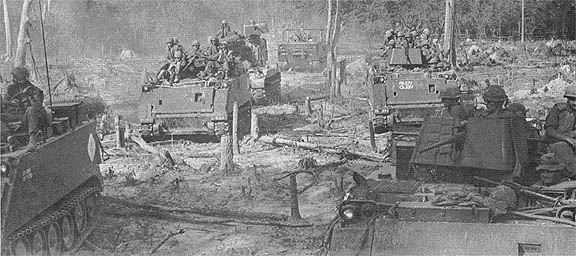 |
| A mass of Armored Personnel Carriers rumbles over felled trees in Cambodia searching for enemy equipment and supplies. These APCs of the 2nd Battalion (Mech), 22nd Infantry, and others of the 1st Battalion (Mech), 5th Infantry, were part of Operation Bold Lancer operating below the Dog's Face section of the border region. (Photo by SP4 Henry Zukowski) |
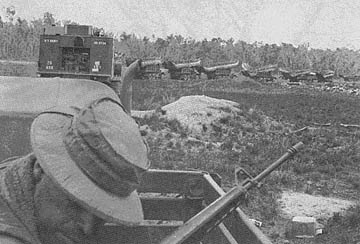 |
This procession of 65th Engineer Battalion trucks slashed through War Zone C to the Rach Cai Bac River where the pontoons shown above were used to construct a bridge that carried 25th Division mechanized units into Cambodia. (Photo by SP5 Steve Kroft) |
| Bunkers like this one had to be laboriously and carefully checked for signs of the enemy before they could be evacuated of rice and other enemy supplies in Cambodia. (Photo by SP4 Charles C. Self) |
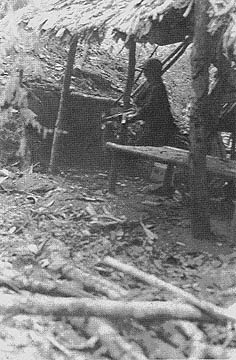 |
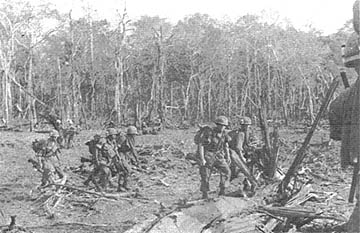 |
Elements of the 3rd Battalion, 22nd Infantry, move toward the woodline of their LZ after they were airlifted into Cambodia during Operation Bold Lancer. The 3/22nd was the first 25th Division unit into Cambodia. (Photo by SP4 Charles C. Self) |
Page 4-5 TROPIC LIGHTNING NEWS July 6, 1970
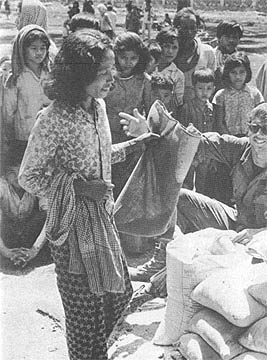 |
A Cambodian woman collects rice at a food distribution point set up in the city square while US troops carry out a cordon and search of Memot. |
| Villagers at Memot gather outside the aid station in their town square. A MEDCAP was being conducted in the tent during a cordon and search of the village. More medical aid was available in a nearby school. |
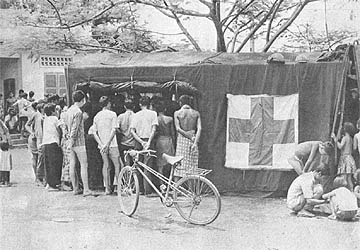 |
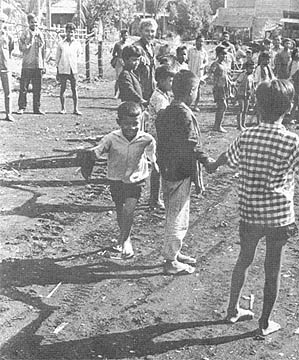 |
As US troops searched the city of Memot, civic actions troops conducted games for the children in the city square. Here the children play drop the hankerchief. |
Civic Actions Pay
MEMOT - One of the most important parts of US operations in Cambodia was
civic action projects.
The care taken to not harm the civilians and their property led to a casual
rapport with villagers that helped in the tactical operations against the NVA.
One operation called for troops of the 4th Battalion (Mech), 23rd Infantry
(Tomahawks), and the 2nd Battalion, 60th Infantry, to cordon and search the city
of Memot.
The primary objective was to uncover enemy weapons, equipment and food
believed to be hidden in the city of 8,000 people.
In order to achieve maximum benefit during the operation, it was decided to
conduct a MEDCAP, give out food and conduct other civic action projects while
the search was underway.
First Lieutenant Michael Wiggins, of White Bear Lake, Minn., the Tomahawk
PSYOPS (Psychological Operations) Officer coordinated the efforts of the various
units attached to the battalion for the operation.
In addition to the MEDCAP facilities there was also an Interrogation of
Prisoners of War (IPW) team, a Civic Action Team (CA), and the 25th Military
Police Company.
The center of activity was the town square where the MEDCAP and food
distribution centers were set up and the movies and games for the children were
held. It was there also, in the post office, that suspected VC/NVA or Communist
sympathizers were brought for questioning.
Regarding the MEDCAP, 1st Lieutenant Robert Anderson, of Youngstown, Ohio, the
Tomahawk Medical Officer, remarked, "This was the biggest combined MEDCAP I've
seen in either Vietnam or Cambodia. We had both a doctor and a dentist in
addition to my medics." Anderson estimated that more than 600 people were
treated during the day.
The food distribution was handled by Captain Chuck Gilmer, of Lancaster,
Tex., who is in charge of the 2nd Platoon, 2nd Civic Action Company. He and his
men brought Corn-soya milk, rolled oats, corn meal and Bulgar wheat to hand out
to the people, in addition to rice captured by the Tomahawks earlier that week.
The residents of Memot had been told by loud speaker that, with the exception
of one person per family, they were all to gather in the town square. While the
families were being entertained and given medical treatment, the Tomahawks were
making a thorough search of the Cambodian houses and yards.
At each home, the one person who remained behind escorted the US troops
through his house, ensuring that his property was handled safely. Where enemy
weapons or materiel were found, suspicious persons were taken for interviews
with the IPW team.
"The people showed us everything they had," said Specialist 4 Larry
Glotfelty, of Grantsville, Md., a rifleman with C Company Tomahawks. "One man
even showed us a bag full of money - his life savings."
Specialist 4 Stephen Lee, of Kenyon, Minn., also a Charlie company rifleman,
recalled, "They sat us down, brought out chairs under the shade trees and
offered us tea and fresh pineapple."
The search of Memot uncovered many small enemy caches. Among the many items
found were two 57mm Recoilless Rifles, five 20mm magazines loaded with
ammunition, a Remington Springfield .30 caliber rifle, three British rifles, 25
anti-tank mines, 188 rifle grenades and 125 pounds of medical supplies.
|
Story by |
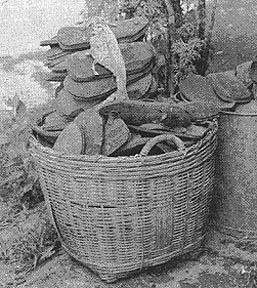 |
These Ho Chi Minh sandles were among the evidences of the enemy uncovered during the search of Memot. |
| Men of the 2nd Battalion, 60th Infantry, and the 4th Battalion (Mech), 23rd Infantry, use a mine detector in the search for enemy weapons during a cordon and search of Memot. |
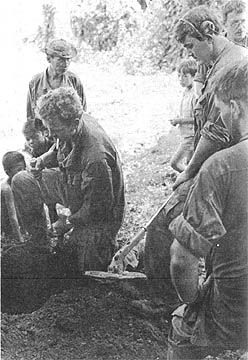 |
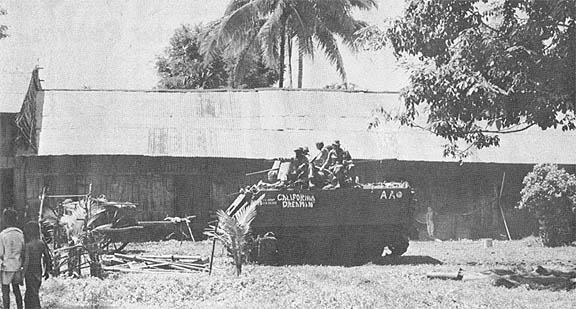 |
| An APC of the 4th Battalion (Mech), 23rd Infantry, stands guard outside buildings in the city of Memot. While 4/23rd conducted a cordon and search of the village, civic action units entertained the people and gave them medical aid in the city square. |
Page 6 TROPIC LIGHTNING NEWS July 6, 1970
Troops Work Well Despite Confusions
By SP5 STEVE KROFT
Armored personnel carriers of the 2d Battalion (Mech), 22d Infantry, rumbled
down the dirt road towards the village of Tasek like a welcome wagon from the
twentieth century.
Handsome villagers lined the road waving and offering the traditional
Buddhist greeting with elbows out and palms pressed together. It was to become
the Cambodian translation for the peace sign.
Even the most callous GI had to be impressed with the moment. These two
distinct cultures rubbing together for the first time gave a profound sense of
history to the early stages of the Cambodian operation. Americans who had been
avoiding booby traps and fighting an invisible enemy near nameless villages,
seemingly unnoticed, were suddenly on the front pages of every newspaper in the
world.
While the operation brought a fear of the unknown, only a few could deny that
there was purpose in this mission. If nothing else, this pleased the grunt.
The operation began amid confusion in a clearing a few miles east of the
Cambodian border. On the morning of May 6, Thien Ngon was little more than an
airstrip with a few scattered tents. Three weeks later it would have
refrigerators, tape decks and barbers in residence, but this day it was merely a
hole in the woods.
For most of the people there, this was their first trip into War Zone C. The
imposing treeline was unnerving, but there was security in knowing that
somewhere between Thien Ngon and the Rach Cai Bac River there was an entire
infantry brigade.
MOVING PEOPLE
People were running around trying to find their units. Yet, while confusion
was disconcerting, it was only a by product of what the Army does best - moving
lots of people and things quickly. Not many people knew where they were, but
everyone knew what he was supposed to do.
Television crews from major networks were there to package the whole episode
up for people back in Des Moines and Cleveland. But by the time the taxpayers
saw it, the troops would be off somewhere to the West.
The villagers were terrified at first, and with good reason. The NVA had
told the people that we would kill them or worse. Many GIs felt an almost
desperate urgency to make the Cambodians understand that we would not harm
them. Trying to reassure the people was not always easy, as one intelligence
officer found out. He found himself saddled with the task of explaining the
presence of his mechanized battalion across the road from the Cambodians'
village. He ended up by trying to explain U.S. involvement in Southeast Asia
through two Vietnamese interpreters, with uncertain results.
WINNING CONFIDENCE
It was frustrating at times trying to convince the Cambodians that we were
their friends and at the same time fighting the war around them. But the
soldiers won their confidence as time went on. And by the time U.S. troops
abandoned Fire Support Base Sharron, the official rate of exchange was eight
American cigarettes for one Cambodian pineapple.
The most significant aspect of the operation was the large cache finds.
Besides providing an unprecedented wealth of war souvenirs, they were tangible
evidence of success. But the GIs soon found that uncovering caches was much
easier than evacuating them to rear areas.
After the novelty wore off, weapons and ammunition discoveries seemed
commonplace. The items that really caused excitement were things like land
rovers, typewriters and IBM printouts.
Days turned to weeks and became a month. The caches were harder to find, and
some of the early luster began to fade. Weeks in the field began to take their
toll. Cambodia was off the front pages and all of a sudden the entire affair
seemed like a lot of hard work. Comfortable rear areas became more remote and
people began to refer to Tay Ninh as the "world."
ANTICLIMAX
If the first thrusts into Cambodia were historic, the withdrawal was
anticlimatic. We went in with full brigades and came out a battalion at a
time. The division formulated plans to make the return trip as memorable as
those first few days had been.
The 3rd Battalion, 22nd Infantry, had been one of the first units to assault
the Communist sanctuaries. On return to Dau Tieng they were greeted with cold
drinks, music provided by the 25th Division Band, and best, service club girls.
One tired trooper straggled off the plane, grabbed a cup of colored water,
and plopped himself down under a large tree. A Red Cross girl sat down beside
him and asked how the operation had gone.
He paused deliberately and then answered. "Great. We did real well."
"Are you glad to be back?" she asked.
A blank stare came over his face as he surveyed the perimeter of Dau Tieng.
"You know something," he said, "I never thought this place could look so
good."
Monster Returns
THIEN NGON - They called him "Monster" Mongoose, and they named a fire
support base after him.
The men of the 1st Battalion, 8th Artillery, explained that he had been
wounded by accident and since their mascot wouldn't qualify for a purple heart,
the namesake Brigade patch now adorns the helipad here.
Monster had been in a box when the unit moved from one location to another.
"We were the first load in," explained Private First Class Jeff Madonna of
Philadelphia. "They set the gun down, then landed so we could get off.
"We set Monster's box near the gun. Before we knew it, here comes the next
load in. We ran for cover and when we came back Monster's box was gone."
The second helicopter had blown Monster and his box nearly 15 yards. Madonna
said they located the box but the Mongoose was nowhere to be found.
But during a mad minute the next night, he recalled "here comes Monster
limping into the FDC (Fire Direction Center) with an M-16 round through his leg.
"One of our section chiefs wants to put Monster in for a purple heart, but
our CO told us he wouldn't qualify," he said.
Instead, the new fire support base, until then without a name, became Fire
Support Base Mongoose.
|
ILIKAI EAST BY NIGHT: |
||||
|
Ask SGT Certain
Dear SGT Certain: Do you have any hints about how to avoid being chased by
water buffaloes?
LANCE T. "HOOF" MARKS
DEAR HOOF: Water buffaloes, of course, are more afraid of you than you are of
them, unless they are in a rotten mood. Unfortunalely, water buffaloes usually
are in a rotten mood. (This is understandable. What, after all, does a water
buffalo have to be happy about?) So it's up to you to put him at ease. One way
to do this is offer him a handful of water buffalo food. (The new, improved,
"SGT Certain's combination Water Buffalo Food and Mosquito Repellent should be
available soon at your local PX and EM clubs.) Or you can walk over to him and
scratch him behind the ears (although it may be difficult to get that close).
Page 7 TROPIC LIGHTNING NEWS July 6, 1970
Toan Thang 43
Operation Toan Thanh 43 began May 10 when the 25th Division's 2nd Brigade
swept north from War Zone C into an area believed to shelter elements of a major
headquarters controlling NVA operations in South Vietnam.
The 3rd Squadron, 4th Cavalry, rumbled across the border to secure main
routes in the area as the 1st Battalion, 27th Infantry, air assaulted into enemy
strongholds.
Next, the 3/4 Cav set up on the southern and western sides of a major
stronghold believed to contain the enemy headquarters. The 2nd Battalion, 27th
Infantry, and the 4th Battalion, 9th Infantry, attacked from the north.
The 2nd Battalion (Mech), 47th Infantry (under operational control of the
25th Division), moved in from the east.
As the trap closed, the units found vast supplies and evidence that they had
destroyed what was once part of a major enemy headquarters.
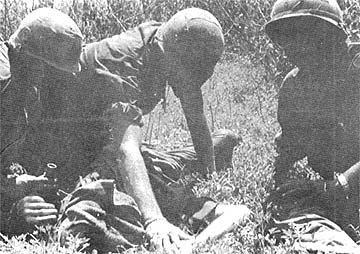 |
As the operations continued, the enemy struck back, usually from small, hit and run ambushes. But he had been hurt badly and his attempts at retaliation met only isolated success. (Photo by SP4 Charles C. Self) |
| Mobility was a key factor in Cambodian operations. Airlifts like this one taking the 4th Battalion, 9th Infantry, into Cambodia, gave leg units the power to take the enemy by surprise. Lifts were provided by helicopters from the 269th Aviation Battalion. (Photo by SP4 Charles C. Self) |
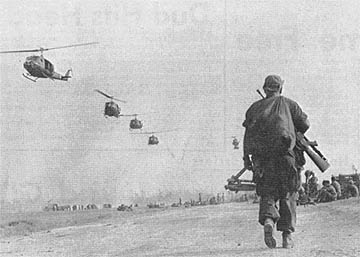 |
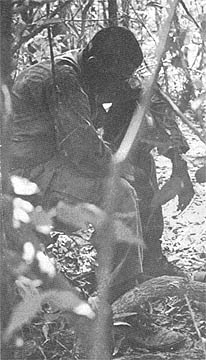 |
A "Wolfhound" of the 2nd Battalion, 27th Infantry, takes a break during operations in Cambodia. The unit was one of those helping to dig up supplies in a major headquarters area. (Photo by SP4 Henry G. Zukowski Jr.) |
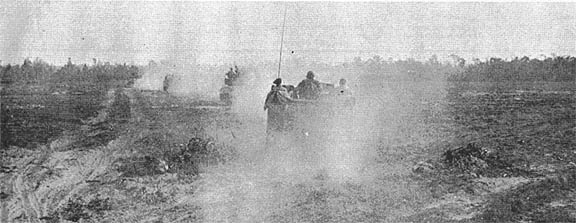 |
| This is how it looked during fast-moving operations in Cambodia as tracks of the 3rd Battalion, 4th Cavalry, swept into Communist sanctuaries north of the Dog's Face. Initial operations were swift, bold strikes that took the enemy by surprise. Later the laborious, block by block search began. (Photo by SP4 Joe O'Rourke) |
Page 8 TROPIC LIGHTNING NEWS July 6, 1970
Courtesy of Jo
E.M. Call Home Free
By SP4 RICH DOMBROWICKI
CU CHI - "Hello, Sweetheart. Guess what? I'm calling you for free! How
about that? Over."
Thanks to the efforts of a gracious lady in Michigan, 25th Infantry Division
personnel may enjoy a free telephone call to "the world."
All enlisted men in grades E-6 and below are eligible to participate in the
Jo's Operation Telephone Home -- Tropic Lightning Division" program in
connection with the division's Military Affiliate Radio System (MARS) stations.
The program is designed to enable Tropic Lightning GIs to make a collect call
to their loved ones at home without the usual cost to the recipient. The usual
MARS call involves a cost to the party called from wherever the connection is
made in CONUS.
After completion of a "Jo call," the GI' fills out a form giving the name and
address of the party he called and the date. The form goes to the G-1 office at
division headquarters, is processed there, and a check for $3.00 is sent to the
called party. The $3.00 is usually more than enough to cover the charges for
the three-minute call.
"The funds for the program come from Miss Josephine McDonell, not from the
25th Division," emphasized First Lieutenant Thomas Willoughby, Rochester, N.Y.,
fund custodian and assistant G-l. "Our office merely administers the fund."
Miss McDonell, of Owosso, Mich., has sponsored "Operation Jo" for the last 22
years to benefit men of all the services. "She's a woman with a great big
heart," Willoughby added, "and her program is a solid morale builder, both here
and at home."
The G-1 office receives letters of thanks everyday from grateful parents,
wives and sweethearts who have been helped through Miss McDonell's kindness.
"One woman even returned the check because the cost of the call was low and
she wanted someone else to benefit from `Operation Jo'," said Private First
Class John C. Eaton of G-1.
"Jo calls" are also being used as incentive by many unit commanders. If a
soldier has given distinguished service to his unit, his CO contacts a MARS
station and sets up an appointment for that man to make a "Jo call."
" 'Jo calls' can be made from the MARS stations at Cu Chi and Tay Ninh, and
from mobile MARS stations that tour the support bases," Eaton, of Mocksville,
N.C., went on. "Calls can also be made from the Waikiki East (Cu Chi) and
Holiday Inn (Tay Ninh) stand-down areas."
"Operation Jo" has been in effect for Tropic Lightning troops since December,
1969. "Since then, we have put through more than 600 free calls," Eaton added,
"and the program will continue indefinitely."
Holiday Inn Warriors
Standdowns Uwind GI's
By SP4 ED TOULOUSE
TAY NINH - The 25th Division "Warriors" of Charlie Company, 2d Battalion,
12th Infantry, returned from successful operations in Cambodia recently to
receive a well-earned taste of the "good life" at the Holiday Inn -- the First
Brigade's standdown area here.
A few beers, new fatigues and boots, visits to the snack bar, PX, and steam
bath, and a floor show spiced by the typical responses of GIs fresh from the
field - these were the ingredients that outlined the Warriors' three-day
standdown.
Arriving by convoy from 24 days of existence in makeshift shelters at Katum,
the Warriors were in typical field attire - worn clothing and weary bodies
colored red by Cambodian clay.
Once settled at the "Inn," however, any semblance of their former selves soon
vanished. Light-hearted GIs, perhaps a bit self-conscious in their new fatigues
and boots, quickly made their way to Tay Ninh's PX complex to purchase things
which they had anticipated buying for about 105 days.
The typical Warrior has learned to appreciate the little things in
life-sleeping on a mattress, not pulling guard duty, forgetting about his rucksack for a few
adays. These, as well as floor shows, movies, and steam baths are an important
part of a standdown.
But for each Warrior, the standdown has its particular purpose. For Staff
Sergeant Jeff Szabo of Bowling Green, Ohio, it was the opportunity to make a
"Mars Station" call to his wife in America.
"Standdowns are almost a necessity for the guys in the field," said Belden,
who had 25 days left in the Army.
Dud Hits Head
KATUM - Enemy mortars can be a real headache.
Take Chuck Cooper, for instance. The private first class was out looking for
enemy caches with Charlie Company, 2d Battalion, 60th Infantry, when the men ran
into an immense NVA bunker complex complete with defenders.
The NVA opened up with Rocket Propelled Grenades (RPG) and mortars wounding
Cooper - sort of.
"Somebody said he was hit with a mortar round," said Cooper's platoon
leader. "I asked if he was dead and the guy said no...only hit."
The round had hit Cooper in his helmet, producing a large dent and a bad
headache, but the round didn't explode.
"I don't know if he will get a purple heart or not, since it did not break
the skin," explained the officer.
Cooper was unavailable for comment. He was in the hospital with a very
swollen head.
Trzeciakiewicz - No Snake's Bait
NEAR KREK AIR FIELD, CAMBODIA - Not many men of the 2d Battalion, 22d
Infantry, had encountered snakes while in Vietnam.
When "Triple Deuce" Regulars began operations in Cambodia however, it wasn't
long before crawly creatures came creeping along.
"I had never seen a snake back in Vietnam," said Specialist 5 Dennis
Trzeciakiewicz, of Delta Company, from Brooklyn, N.Y. "But one night as we were
setting up at a new night laager site, it looked like it would rain. So I got a
wooden pallet to sleep on and put it next to my armored personnel carrier so
that with overhead cover I could stay dry."
The next morning, when Trzeciakiewicz picked up the pallet, Specialist 4
Clifford Skow called over, "Don't move, Denny," and pointed at a three-foot long
snake that had been sleeping under the pallet.
"I jumped about four feet backwards," Trzeciakiewicz recalled. "The snake
then coiled up and drew a bead on me."
Meanwhile, Specialist 5 Earl McKinney, of Headquarters Company, from Atwater,
Ohio, grabbed a pick-axe and circled around the carrier to get behind the
reptile. As the snake was about to strike, Mc Kinney struck first. In seconds,
the snake was in thirds.
Several days later a similar encounter took place. Several men from
Headquarters Company noticed two snakes wrapped around a banana tree at another
night laager position. When it was decided that these snakes were determined
Cobras, a Triple Deuce Flame track was called in. Within seconds the snakes
became "crispy critters."
Among the many comments of the Triple Deuce grunts, the main one was, "We're
glad we found these snakes before they did a job on us. It's bad enough coping
with the NVA without getting messed up by a snake."
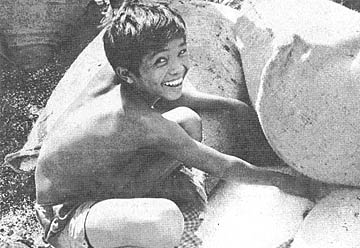 |
ALL THAT FOOD - A young Cambodian scoops up some of the captured enemy rice collected by the 4th Battalion, 9th Infantry. The rice was distributed to Cambodian refugees. (Photo by SP4 Lawrence C. Merritt) |
Nurse Rouses Early Christmas Cheer
By SP4 GEORGE GRAHAM
CU CHI - Christmas arrived at the 25th Division's 12th Evacuation Hospital a
full six months early this year.
On June 25th, more than 75 patients at the hospital received gifts, letters
and baked goods as the result of "Operation Santa: Christmas in June."
The project was the brainchild of Mrs. Pat Beyersdorf, of Omaha, Neb., a
woman of apparently boundless organizational energy when it comes, to helping
fellow Americans bedridden in a foreign land.
"Operation Santa: Christmas in June" is in its second year in military
hospitals. In June 1969, it was organized by the Far East Nurses Club in
Japan. Working with gifts received from all over America, parties were held in
three Army and Air Force hospitals in that country.
Stationed at the time in Japan with her husband, Warrant Officer Charles
Beyersdorf, Mrs. Beyersdorf was enthused by the idea of bringing Christmas cheer
to the bedridden in June; so enthused, in fact, that this year she is helping to
guide the project from Omaha.
Through her work as a Red Cross bloodmobile nurse, she organized two towns,
Beatrice, Neb. and Underwood, Iowa, through the towns' civic leaders.
"The response," she said, "to a summer Christmas in Vietnam was
overwhelming. Although the entire project is geared along the lines of several
Pacific military hospitals, the two towns elected to adopt the Cu Chi hospital
on more personal terms."
Mrs. Beyersdorf thought of Cu Chi immediately because her husband's best
friend, Warrant Officer George Northrup, of Bristol, R.I., is assigned to the
269th Aviation Battalion (Combat), headquartered at Cu Chi.
Working through the Chaplain's office of the 269th, schools, churches and
clubs of Beatrice and Underwood shuttled enough packages so that each patient at
"12th Evac" would have more than two gifts, plus baked goods and letters.
Because the 269th is now without a chaplain, the assistant, Sergeant Ron
Applegate, of Cincinnati, coordinated the battalion's efforts with Chaplain
Patrick Adkins of 12th Evac.
Mrs. Beyersdorf said, "The patients at Cu Chi's hospital are not the only
ones who are getting a great feeling from being Americans working for
Americans. We, at home, are given a boost because we finally feel we are able
to do something to help the men who do so much for us."
She also said one of the volunteer workers in Beatrice, Mrs. Delmar Bell, had
told her the town had a holiday spirit while preparing Christmas packages for
the men. Grammar schools and Sunday school classes worked along with adult
organizations.
The response from the men, most of them assigned to the 25th, as they saw the
gaily decorated wagons bearing out-of-season Christmas packages was that of
bemused disbelief.
"What, Christmas in the summer? You've gotta be kidding."
"Impossible, but I'll buy it!"
So each wounded man at the hospital now has a midseason pick-me-up in the
form of gifts and letters.
Thanks to:
Harold Reed, 187th Crusaders,
for sharing this issue,
Kirk Ramsey, 2nd Bn., 14th Inf. for creating this page.
This page last modified 06-18-2005
©2005 25th Infantry Division Association. All rights reserved.